
MAY CONTAIN NUTS

Search Shorpy
SHORPY ART

Framed or unframed, desk size to sofa size, printed by us in Arizona and Alabama since 2007. Explore now.
Join and Share
Ad-Free Shorpy
Shorpy is funded by you. Patreon contributors get an ad-free experience.
Learn more.

Recent comments
- Indiana Harbor Belt abides
- Freezing haze
- Corrections (for those who care)
- C&NW at Nelson
- Fallen Flags
- A dangerous job made worse
- Water Stop
- Passenger trains have right of way over freights?
- Coal
- Never ceases to amaze me.
- Still chuggin' (in model form)
- Great shot
- Westerly Breeze
- For the men, a trapeze
- Tickled
- Sense of loneliness ...
- 2 cents
- Charm City
- What an Outrage
- Brighton Park
- Catenary Supports
- Just a Little Before I was Born
- Afternoon normal
- The Flat Iron Cafe survives
- Aging in Place
- Raise your hand
- Good and Bad
- Oh, the 70's
- Nooooooi
- The aluminum tubing
Member Photos
The Shorpy
Print Emporium
Print Emporium
Search Shorpy
Search results -- 30 results per page
- Coal Country: 1910
- Circa 1910. "Coal loading at Ford Collieries, Allegheny County, Pennsylvania." 8x10 inch dry ... there might be an undefined one.
(The Gallery, DPC, Mining, Railroads) ... Posted by Dave - 09/04/2017 - 10:37pm -
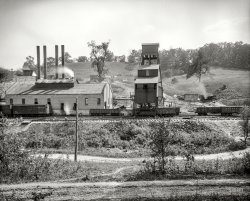
- Coal Creek: 1910
- December 1910. Coal Creek, Tennessee. "Hard work and dangerous for such a young boy. James ... Mountain Mine, Knoxville Iron Co., in the vicinity of Coal Creek. James has been there four months. Helps push these heavily loaded ... (built of course much later)
(The Gallery, Lewis Hine, Mining) ... Posted by Dave - 08/13/2008 - 8:29pm -
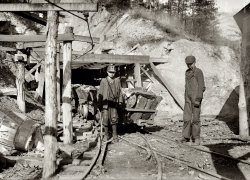
- Shut This Door That Means You
- ... old. Has trapped for several years in a West Virginia coal mine at 75 cents a day for 10 hours work. All he does is to open and shut ... by himself by the light of his hat-candle.
Canary in a coal mine Don't scare the birds
Vance, trapper boy Vance Swisher ... look at the past.
(The Gallery, Kids, Lewis Hine, Mining) ... Posted by Dave - 01/08/2009 - 11:24am -
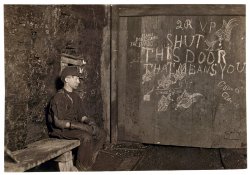
- Scared of School: 1908
- ... Grafton, West Virginia. "Tipple Boy and Drivers. Maryland Coal Co. mine near Sand Lick. Boy with mule was afraid at first to be in the ... the brightness of the flame.
I was born in coal mining country in the 40's, and later came to discover through a friend how the ... Posted by Dave - 09/25/2008 - 2:52pm -
![Scared of School: 1908 September 1908. Grafton, West Virginia. "Tipple Boy and Drivers. Maryland Coal Co. mine near Sand Lick. Boy with mule was afraid at first to be in the picture; another boy said he feared we might make him go to school." View full size. Photograph and caption by Lewis Wickes Hine.
How could it be?How could school be any worse than this? I suspect that they didn't have a choice to go to school as their families probably needed the money.
["Worse than this" -- it says something about life today when we can't wrap our minds around the possibility that these boys might actually have liked working. - Dave]
Shocked. Shocked!I'm shocked! One of them is smiling -- I'm surprised Hine didn't destroy the negative and demand another be taken with all-scowling faces.
Coal CampYeah, I'm sure many of the jobs back then were horrible, but I can't imagine any kid not wanting to work with horses (or mules)--- and ditch school at that. That's not far off from what many of the well-to-do pay good money for their kids to do at expensive summer camps, after all!
HeadgearI would love to know what is on the boys' hats.
[Headlamps like these. - Dave]
Carbide LightsI think the name of the lamps on the boys heads were carbide lights. My dad has a couple of the ones my grandfather wore.
My Sweetheart's the MuleMy grandfather, who started working in a coal mine about a decade after this photo was taken, used to sing this ditty to me:
My sweetheart's the mule in the mines
I drive her without reins or lines
On the bumper I sit
And I chew and I spit
All over my sweetheart's behind.
Carbide lamps..Those are, in fact, carbide lamps, which worked by dripping water (regulated by a valve) onto rocks of calcium carbide in the body of the lamp. The amount of water determined the amount of gas produced, and therefore the brightness of the flame.
I was born in coal mining country in the 40's, and later came to discover through a friend how the flammable gas produced by calcium carbide could be used to power deafeningly loud paint-can cannons.
Also, BTW, most of us would rather have gone to work than school, I think...
Mine HeadlampsOops, I just looked at the other photo of open-flame headlamps (which in fact I'd never seen before). Were the carbide (enclosed) variety considered "safety devices"?
Great site full of the America I grew up in. Thanks...
LampsThose are oil lamps on their hats. Shaped like a little watering can, they held whale oil with a wick that went down the spout.
(The Gallery, Horses, Kids, Lewis Hine, Mining)](https://www.shorpy.com/files/images/01074u.thumbnail.jpg)
- Coal Miner's Son: 1939
- May 1939. Coal miner's son in Kempton, West Virginia. View full size. 35mm nitrate ... in Garrett County, MD, just over the WV line. Small mining town, where my Dad was born.
Not much left there these days, ... Company Stores.
(The Gallery, John Vachon, Kids, Mining) ... Posted by Dave - 12/11/2007 - 9:40pm -
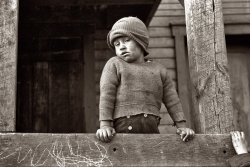
- Coal Miner's Daughter: 1938
- September 1938. "Children of coal miners. Scotts Run, West Virginia." Medium format nitrate negative by ... tens of years ago!
(The Gallery, Kids, M.P. Wolcott, Mining) ... Posted by Dave - 03/17/2017 - 11:37am -
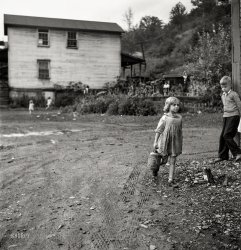
- Breaker Boys: 1900
- ... Pennsylvania, circa 1900. "Breaker boys, Woodward coal mines." 8x10 inch dry plate glass negative, Detroit Publishing Company. ... boys' job was to separate rocks and other debris from coal by hand. Although breaker boys were primarily children, men who could no ... Granddad lived to be 78, had both legs broken in mining accidents, had heart and respiratory trouble (spitting black) and a ... Posted by Dave - 08/13/2012 - 7:20pm -
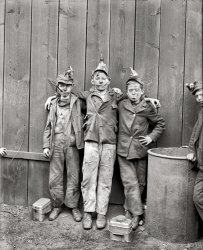
- Breaker Boys: 1911
- ... January 1911. Breaker boys in #9 Breaker, Pennsylvania Coal Company mine at Hughestown Borough near Pittston. Smallest boy is Angelo ... of western Pennsylvania. According to my now retired mining expert, in the days when mules were used in the mines, the mules were ... Posted by Dave - 07/24/2012 - 6:59pm -
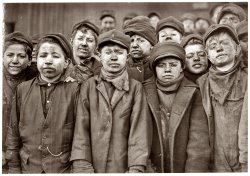
- Plymouth Breaker: 1901
- Plymouth, Pennsylvania, circa 1901: "Plymouth coal breaker." 8x10 inch dry plate glass negative, Detroit Publishing Company. ... else
Popular Mechanics, 1908
Largest Coal Breaker in the World
The huge coal breaker at Plymouth, Pa., known ... coal yard or even a hardware store.
(The Gallery, DPC, Mining, Railroads) ... Posted by Dave - 08/08/2012 - 2:30pm -
![Plymouth Breaker: 1901 Plymouth, Pennsylvania, circa 1901: "Plymouth coal breaker." 8x10 inch dry plate glass negative, Detroit Publishing Company. View full size.
Mechanical DevicesThey may be taking over in the operation of the breaker, but somebody is going to have to do some serious shoveling to unload those boxcars! And it looks as if this is an accepted method as there are several flat cars full of ready cut boards waiting at close hand. I can't imagine what the purpose of the gondola/flat car combo can be for. There seems to be another set in the loading shed and one farther down the other side. Very perplexing!
Perhaps they are processing so fast that they need to use every available car until they can acquire or manufacture new gondolas?
The Parrish BreakerThis photo appears on Wikipedia under "Plymouth, Pennsylvania" and is identified as the second Parrish Breaker.
Here, as everywhere else
Popular Mechanics, 1908
Largest Coal Breaker in the World
The huge coal breaker at Plymouth, Pa., known as "Nottingham No. 15," is the largest in the world. Its capacity is 1,000 cars of a size large enough to carry an equivalent of 7 tons of finished coal each. Not more than 200 ft. from the breaker is a shaft 350 ft. deep from which one of these cars arrives with coal from the mines every 20 seconds.
Here, as everywhere else, mechanical devices are superseding manual labor. In the old-style breaker at least 150 men and boy pickers were employed, but in this breaker a spiral coal-picking machine has made it possible to dispense with at least half of that number. The breaker cost $200,000.
[Note: the breaker pictured above may not be the one described in the Popular Mechanics article. Nor does it appear to match any of the other PA anthracite breakers cataloged at this site.]
Plymouth commentsThe boxcars are likely outbound. Some anthracite customers ordered coal in boxcars, as there was less pilferage. (Note there is another boxcar under the breaker).
Looking at the hi-def image, a locomotive is seen in the distance that appears to be an inspection engine. It has a high cab with the bell mounted on the front end sill. There probably are several business cars behind it; difficult to see at this distance.
An inspection engine indicates a visit from the "brass." The grounds were spruced up ahead of time for sure.
Camelback LocomotiveThe type of locomotive in the back isn't an "inspection" locomotive as another poster called it, but is instead a camelback. This type of locomotive was somewhat common in the early 20th century, but fell out of favor due to people fearing they weren't safe. They still hung around in places like yards and industrial applications; but generally speaking they died out. Only one has been preserved in working condition.
Inspection LocomotiveThe high cab roof, along with the bell mounted on the front deck, says inspection locomotive, an entirely different animal compared to a camelback.
The oversize cab was necessary to accommodate the officials who were doing the inspecting of railroad facilities. The inspection engine could run alone while on business, but often hauled private or business cars, as appears the case here.
BTW, at least two camelbacks have been preserved: DL&W No. 952 4-4-0W at St. Louis Museum of Transport, and CRRNJ 4-4-2W at B&O Railroad Museum in Baltimore.
"American" camelbackShilo would seem to be correct. The construction of the engine more resembles an early "American" type camelback. Not American 4-4-0, but instead this type of locomotive.
The PRR owned six of this class of locomotive, with the B&O having 50. Only one has been preserved of this class, though it is not in running condition. Due to its construction, it is not unexpected for them to be mistaken for inspection trains, which were a very different beast entirely.
This type of locomotive was rendered obsolete by 1910, due to improvements in boiler design. By then, most had been withdrawn from service or rebuilt into "conventional" cabbed locomotives.
Also, only one "modern" Camelback, Reading Company 0-4-0 No. 1187, survives in operable condition. The remaining preserved locomotives are lacking in nature, with Baltimore & Ohio Railroad 4-6-0 No. 173 suffering from a cracked boiler crown sheet and failed boiler certificate, and Central Railroad of New Jersey 4-4-2 No. 592, having been severely damaged when the roof of the museum gave way under heavy load in 2001-2002. Lastly, Delaware, Lackawanna & Western 4-4-0 No. 952, is in no condition to operate, missing may integral parts, and B&O Camelback 2-8-0 #173 (Of this class in the photo) Being too old to consider repair and operation.
BoxcarsCoal shipped in boxcars, rather than hopper cars, was shipped in fifty pound burlap bags. Usually sold in the larger cities to customers who preferred to buy it that way as it could be picked up at any coal yard or even a hardware store.
(The Gallery, DPC, Mining, Railroads)](https://www.shorpy.com/files/images/4a07311a.thumbnail.jpg)
- Children of the Coal: 1938
- September 1938. "Coal miner's wife and three of their children. Company house in Pursglove, ... it.
(The Gallery, Kids, Kitchens etc., M.P. Wolcott, Mining) ... Posted by Dave - 03/12/2017 - 7:19pm -
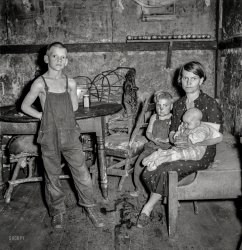
- Heart of Gold: 1942
- ... (vicinity). Montour No. 4 mine of the Pittsburgh Coal Company. Coal miner at end of the day's work." Medium-format negative by ... Ageless If that's Shorpy Higginbotham after decades of mining, then mining certainly agrees with him! Scholars of Shorpy Higginbotham ... Posted by Dave - 09/13/2011 - 11:10am -
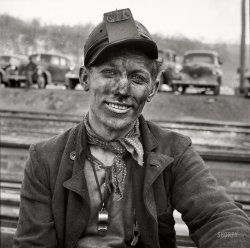
- Carboniferous: 1900
- ... Pennsylvania, circa 1900. "Breaker boys at Woodward coal breaker." 8x10 inch dry plate glass negative, Detroit Publishing Company. ... Hat Rack Apologies if you've covered this on an earlier mining photo, but what are the tools attached to their hats? Kind of an ... Posted by Dave - 08/05/2012 - 4:26pm -
![Carboniferous: 1900 Kingston, Pennsylvania, circa 1900. "Breaker boys at Woodward coal breaker." 8x10 inch dry plate glass negative, Detroit Publishing Company. View full size.
Look out for that 14th step, boysIf they only had OSHA back then.
How did this happen?. . . without Lewis Hine there to tell them not to smile?
Hat RackApologies if you've covered this on an earlier mining photo, but what are the tools attached to their hats? Kind of an interesting place to put them, though I guess it might get in the way less than a hip holster or something.
[Those are lamps. - Dave]
Love the kid in about the middle of the picture with the dramatic, magazine cover model, hand-on-hip pose!
Paper routes would be betterBreaker boys sometimes had their fingers amputated by the rapidly moving conveyor belts. Others lost feet, hands, arms, and legs as they moved among the machinery and became caught under conveyor belts or in gears. Many were crushed to death, their bodies retrieved from the gears of the machinery by supervisors only at the end of the working day. Others were caught in the rush of coal, and crushed to death or smothered.
All those impish looking boysand not one set of rabbit ears rising behind someone's head. I'm amazed.
Seriously, that had to be a hard life for these kids.
Boys they were!How did the grizzled old-timer (middle of fourth row from the front) feel about being a "breaker boy," surrounded by youths who weren't even shaving yet?
It's difficult to tell what age this grown man is. Did the boys think of him as just an old, played-out loser, or as a man of experience and wisdom? Or did they see their own future in his face?
DreadI dreaded walking into school every morning of my youth. Imagine having to walk up that narrow flight of stairs into that coal breaker every morning. Scary.
A Seaof faces, some hard some soft, some friendly some fearsome, all dirty.
A Different Take on the Old Guy From Wikipedia: "Although breaker boys were primarily children, elderly coal miners who could no longer work in the mines because of age, disease, or accident were also sometimes employed as breaker boys."
His face is pretty clean, so perhaps he was a supervisor. There are a few other older "breaker boys" in the photo, such as the mustachioed gent next to the old guy. Wonder if they were injured miners, or just desperate for work.
The Old GuyI suspect the old guy was not a breaker boy but a supervisor. Judging by his demeanor I bet he didn't take any guff from any of the boys.
Re Hat Rack Cap lamps are almost probably carbide lamps. Carbide chunks are put in a tight container, a little spit is added, gas forms, a lit match is touched to a small hole and POUF, you can see well enough to dig coal down where the sun never shines. My father, who became a miner at age 12 in 1915, said in the winter months he never saw the sun six days out of seven, going to work when it was dark and coming home in the dark. Years later we used carbide lamps during raccoon hunts. Carbide gas also made a nice explosion if you were to, let's say, add some wet carbide to a paper bag full of cotton waste in, oh, say, the alley behind your grandmother's house in Chicago. drop a match or sparkler on it and run like the wind while you got your pre-teen face to look innocent again. I'm just saying.
Here is my grandfather's (name misspelled; I doubt if he spoke much English so I guess that was close enough) coal mining license from 1899, size greatly reduced, issued, as you see, in Plymouth, Pa., about three miles from Kingston. I've cropped the sides into the text in order to maintain some readability within the 490 pix allowance. My dad's brother Joe was killed at age 20 in a mine by falling rock, a very common accident. I wonder if they knew Shorpy?
MeaningPuts a whole different spin on the phrase "wasted youth," doesn't it. These lads had no youth to speak of.
The Good Old DaysYes, the socio-political conditions which allowed employment like this to happen are exactly the type of conditions America needs today, yes sir.
CaplampsThe caps on these young men have oil wick lamps on them. Carbide lights were just coming on the market and did not become popular with miners, even minor miners, for a few years. I still use carbide for caving and collect the caplamps. A little history of mining lights here.
(The Gallery, DPC, Mining)](https://www.shorpy.com/files/images/4a07284a.thumbnail.jpg)
- A Crooked House: 1938
- 1938. "Shenandoah, Pennsylvania. House fronts in a mining town." The off-kilter castle last seen here . Acetate negative by ... sill. And I hope that Sam loved Marie to the very end.
Coal Street Appears to have been 1049, 1051, and 1053 Coal Street. There's a ... Posted by Dave - 04/01/2019 - 9:26pm -
![A Crooked House: 1938 1938. "Shenandoah, Pennsylvania. House fronts in a mining town." The off-kilter castle last seen here. Acetate negative by Sheldon Dick. View full size.
There Was A Crooked House!On a crooked street, and there lived a crooked cat, etc, etc. etc.
A nursery rhyme from when I was a little boy. (not sure if Dave is making reference to that.)
[Thanks DanV]
When one door closesI love to see old houses with doors that open out onto sheer nothingness -- in this case, directly above proper doors that open onto the sidewalk. These upper doors even have their own addresses.
Here's hoping no one sailed out of a second-floor door unwittingly and had to lie up on some Sanotuft bedding to recuperate. But if they did, I hope it was within what must have been a lovely room behind the white starched curtains and scalloped, fringed shades pulled down four-fifths of the way to the sill. And I hope that Sam loved Marie to the very end.
Coal StreetAppears to have been 1049, 1051, and 1053 Coal Street. There's a rather sharp drop in the road just past where 1053 would have been if you look at Google street view.
Dutch doorsThe doors on the second floor appear to be Dutch doors (half doors) where just the top part opens (possibly bottom too as an option). They each appear to have a ledge.
As I remember itThere was a crooked man, who walked a crooked mile;
He found a crooked sixpence upon a crooked stile.
He bought a crooked cat that caught a crooked mouse,
And they all lived together in a little crooked house.
This place? Not so little, but definitely crooked.
Sam gets around.Either that, or else someone is trying to stir up trouble with Nancy. Or Marie. Or both.
(The Gallery, Bizarre, Dogs, Mining, Sheldon Dick)](https://www.shorpy.com/files/images/SHORPY-8c02384a1.thumbnail.jpg)
- Winter Job: 1910
- ... Mountain Mine, Knoxville Iron Co., in the vicinity of Coal Creek, Tennessee. James has been here four months. Helps push these ... Labor Committee. View full size.
History of the Coal Creek My wife lost a Gr-Grandfather, Gr-Gr-Grandfather and 2 uncles in ... the five survivors, either
(The Gallery, Lewis Hine, Mining) ... Posted by Dave - 08/20/2013 - 2:07am -
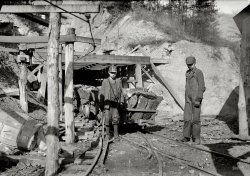
- Breaker Boys: 1900
- ... Pennsylvania, circa 1900. "Breaker boys, Woodward Coal Mines." 8x10 inch dry plate glass negative, Detroit Publishing Company. ... Sharp Higginbotham (Shorpy) was a greaser and died in a mining accident at the age of 32, his wife pregnant with their first child. Joe ... Posted by Dave - 07/24/2012 - 7:15pm -
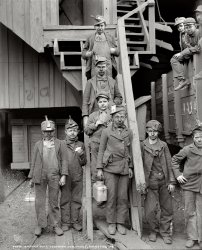
- Left Hanging: 1939
- ... Security Administration. View full size.
Clean coal Naturally, the proximity of all that anthracite had no effect on the ... eclectic collection of workaday New York Central Railroad coal haulers.
Neat stuff from the days of yore when even rusty old train cars had character.
(The Gallery, Arthur Rothstein, Mining, Railroads) ... Posted by Dave - 10/03/2018 - 1:16pm -
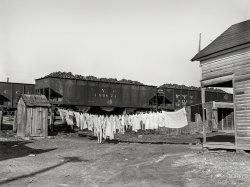
- Family Dinner: 1952
- ... distributed in Asia; poster includes photographs of coal miner Walter Ward and family in David, Kentucky." Gelatin silver print. ... hanging above the stove. Having come from a Pennsylvania coal miner grandfather, my 'take' on this picture is that it was staged, posed ... the mixer and the frig.
(The Gallery, Kitchens etc., Mining) ... Posted by Dave - 10/29/2015 - 10:31am -
![Family Dinner: 1952 1952. "Photo for U.S. Information Agency propaganda poster titled 'I Choose to Be a Miner,' distributed in Asia; poster includes photographs of coal miner Walter Ward and family in David, Kentucky." Gelatin silver print. View full size.
The most used utensilin my grandma's kitchen was the soup ladle hanging above the stove. Having come from a Pennsylvania coal miner grandfather, my 'take' on this picture is that it was staged, posed and fully planned in advance (unless this was on a Sunday when they would have their best meal of the week). The other six week-night suppers were mostly home-made soup and bread, every kind of soup imaginable, more than Campbells could ever come up with. Having a large family, my mom said there was nothing else that could satisfy seven or eight hungry, hard-working people as a filling, hot and inexpensive meal like soup and fresh bread & butter. She was a master soup cook too, taught by her mother, and I was pretty much raised on soup, some heartier than others, but never disappointing. It can be time-consuming to prepare but I've never felt deprived and it really stretches your meat to feed any number of people. (If someone got a big chunk of chicken or beef in their soup, or too many clams in their clam chowder, we used to say "the string must have broke").
... and look! Cake!I do love this photo. It's all shiny and full of bounty. Once you look closely you'll see the financial constraints this family must have faced. I'm left to wonder if she normally served cake at dinner.
Need a new washer on that faucet?If they're under financial constraints, they could help their water bill by either a) turning the faucet off, or b) putting a new washer in it.
MixerIt looks like a '40s Kitchen Aid stand mixer.
[Looks like a Sumbeam Mixmaster to me. -tterrace]
It still works...I bought this Sunbeam Mixmaster for $25 on a trip to Tacoma, Washington, over 20 years ago.
So 1950sThe Mixmaster, the teapot from the Jewel Tea Company, the General Electric range, and all the gleaming surfaces that wipe clean with a damp sponge. Why can't I have a kitchen like that?
Miners at tableNo miners I grew up with ever lived that well, dressed that well nor ate that well. With all the fresh haircuts, clothes, appliances, etc, this was nothing but a stage production. Folks my age will recognize it as such.
[The worn-out stool for a chair and the T-shirt with holes are probably props, too. - Dave]
I'll Second ThatIt looks like the second-hand one in my kitchen--a Sunbeam Mixmaster, which gets frequent use and works perfectly 60+ years on. I bought it minus beaters and must have bought about 50 pairs of beaters before I found the right ones. I have a drawer-full. Maybe they fit tterrace's "Sumbeam".
Miners' HousesThe Wards' house (at right, with the tree), and their neighbors. Click to enlarge.
MixmasterMy mom had one of those. It was an ergonomic beauty: you operated the speeds by rotating the black dome-shaped knob at the far end, and you released the beaters by swiveling the black handle 90 degrees. Ah, and the glass bowls. Seeing that Sunbeam in use on the kitchen counter meant something aromatic and yummy was on the way.
P.S. A place named David! I’m okay with that.
Which?OK everyone, would you like dessert first or these lovely string beans?
Just as I RememberA typical middle class family dinner, as I remember it, from the early 50's, although:
Cake wasn't a normal feature and the kids always had milk (Starlac as I remember and it was terrible) instead of water.
Older sis looks a bit peeved at the main course (it was always someone's least favorite).
Dinner was always in the dining room. Breakfast was always in the kitchen.
Mom was always in a dress but no high heels.
Another vote for the MixmasterThat Mixmaster brings back some pleasant childhood memories for me. My mother had one very similar to the one in the image. I was about the same age range as the boys in the photo in 1952 and I always lobbied to lick the bowl and the beaters after the cake was finished.
they even had a swimming pool...Put in circa 1949...whoda thunk?
A Not-Christmas StoryAm I the only one who looks at this kitchen and sees the "eat like a pig, Ralphie" scene from A Christmas Story in the making?
(Of course I also have one of those Sunbeam mixers, and so does my mother. They are/were indestructible).
Jelly GlassesLove those bird themed water glasses on the table. I have the same glasses my Dad used as a kid. They came from the grocery with jam or jelly in them and then you used the glass later.
Running WaterThe faucet water flow may be intentional, if the supply is by gravity through an uninsulated pipe from a mountain side spring. Otherwise, it could be too hot in Summer, and frozen solid in Winter.
I recognize the sink/counter!Unfortunately, it's because I see it every day in the kitchen of the house I rent. I love the style, but those cupboards are mighty small.
Youngstown KitchensThe logo in front of the sink is from Youngstown Kitchens. Yup, I grew up with them.
Here's what I see….Mother's Swiss-dot curtains are torn on the left panel; her drain rack for her dishes is in its place by the drainboard. She normally uses her table for her counter space, but since the table is set for dinner, she's using her sink drainboard for her Sunbeam Mixmaster which whipped up the frosting. Ah, yes, that tiny black spray nozzle on the sink. Is that grated cheese in the cheese shaker or do they use a lot of salt? The younger daughter has her eyes on the boiled frosting cake, as would be mine as well. Father and the boy are eying the fried chicken. Deviled eggs on a side plate with lettuce? There are sweater 'pills' on the older daughter's sweater, at the farthest point West. Nice white bread, hard to find nowadays with all the nutritious breads forced on us in our stores. Father's hair is combed in a 'combover' on his bald spot. Bet any money that Mother's wrist watch is a Bulova. Mother ironed and 'starched' the tablecloth, so it must be Sunday. Father's shirt is ironed, older daughter's sweater is ironed, younger daughter's dress is ironed, younger son's t-shirt is ripped with holes. The plant at the window is a 'Wandering Jew.' The tin pots and pans are surely much lighter to lift than my All-Clad set today. All in all, the scene resembled by own childhood in 1952, right down to the floral design on the linoleum on the floor.
MenuI'm trying to figure out what they were eating that night.
I can distinguish the green beans and bread and the consensus on the lumpy main course is that it's fried chicken.
I'm curious what's in the bowl underneath the chicken. Potatoes? The side plates look like they have salad on them and that's maybe pickles next to the bread?
I have to assume the cake on the table was for the benefit of the photo. No mother then or now would put dessert out first! I also have to wonder if the ice in the water was there to indicate prosperity, along with the mixer and the frig.
(The Gallery, Kitchens etc., Mining)](https://www.shorpy.com/files/images/SHORPY-07972u1.thumbnail.jpg)
- The Heart of Copper Country: 1905
- ... for When the scorification is coming to an end, enough coal dust is thrown on to sufficiently coat the surface of the metal. Then the ... allowed to continue for several minutes. Then one throws coal dust over the copper again and the bubbling recurs. This process continues ... that info back. Cheers!
(Panoramas, DPC, Factories, Mining, Railroads) ... Posted by Dave - 07/28/2012 - 4:49pm -
![The Heart of Copper Country: 1905 Calumet, Michigan, circa 1905. "The heart of the copper country." Panorama made from four 8x10 glass negatives. This doesn't look like much until you click View full size, whence you are transported into a wondrous cuprous panorama.
Future two by foursI spend a couple of weeks a year in the UP (Upper Peninsula for you non-Michiganders) near Calumet, and train cars carrying lumber south are still a common sight.
Is it roofing season?This is puzzling. Can anyone explain why there are so many ladders up to and across the rooftops? Perhaps the first day of clear weather for repairs?
[What's more likely is that most of those ladders are always there, or there for months at a time. The reason might have something to do with snow. - Dave]
Stacked oddsI can only imagine what the houses would look like if those logs decided to tumble down upon them there does not appear to be anything holding them back other than gravity.
What's upwith all the ladders on so many of the houses?
Scene from an imaginary movieProbably arthouse, maybe Scandinavian?
Ladders + Chimneys = SweepingsThe reason for the roof ladders is to access the chimneys. You will notice that almost every roof ladder is placed along side a chimney, which in the day of constant use required frequent sweeping to prevent flue fires.
300 inches of snowCalumet is on the Keweenaw Peninsula -- the Upper Peninsula's upper peninsula.
U.P. snows are legendary, especially in the Keweenaw Peninsula, where 300-inch winters aren't that unusual. (Sticking far out into Lake Superior, it really gets nailed with Lake Effect snows.) Ladders nailed to roofs are there for a reason. When accumulated snows threaten to collapse the roof, the ladders give a foothold from which to clear off the stuff.
PitchesThe steep roof pitches also help prevent snow from piling up too quickly, but with the amounts alluded to you couldn't be too careful The houses shown set me to remembering the Pete Seeger ditty about all the houses that look alike, but, the name escapes me. The breadth of coverage is breathtaking, amazing. But that snowfall amount is staggering; we had 67 inches over three storms a short time back and thought that was bad.
Spectacular, one of the best on ShorpySo much going on in this view I can look at it for hours.
It almost looks like it was all CGI work done by some FX studio.
Thank YouDue to that 8,461px × 2,000px picture I now have the perfect reason to explain to my wife why I need a new monitor with a resolution of at least 9000 x 2400 so I can use that fantastic panorama work as a background.
She is an artist at heart and has a love of olden times and things so I believe I do have a shot.
Ticky-TackyIt was Malvina Reynolds who wrote "Little Boxes." Pete Seeger covered the song, but always gave credit to Malvina.
STUNNINGThis picture is a real gift. A panoramic moment in time. I agree with RoccoB. One of the best ever in the Shorpy Collection and one that could easily take up a couple of hours of close examination. Thanks, Dave.
DioramaThis is a superb reference point for anyone wanting to create a prototypical, period, industry-representative model railroad layout. Fabulous detail, and all authentic.
I found Waldo!Standing by the garden. Man, it's even tougher in black & white.
Dizzy.The changing shadows across the photo are surreal, but somehow make it seem more physical. I can almost feel myself turning about on top of the hill, the warm breeze carrying the scents of fresh cut lumber and copper mill smoke.
Sears housesI attended Michigan Tech in Houghton, Michigan back in the 1980s and took a class called something like "Social Geography". We traveled all over the Copper Country figuring out why towns were laid out in certain ways.
I do remember going through Calumet and finding rows of nearly identical houses like those shown in the photos above.
Turns out many of them were bulk-ordered straight from the Sears catalog!
What are the trees forWhen the scorification is coming to an end, enough coal dust is thrown on to sufficiently coat the surface of the metal. Then the refiner shoves a tree in the furnace and presses it into the metal as strongly as he can. Because one uses elms or young oaks from four to six inches in diameter which have been freshly cut or left to lie in water to keep them damp, a violent bubbling occurs in the copper when one pushes the tree into it. This is allowed to continue for several minutes. Then one throws coal dust over the copper again and the bubbling recurs. This process continues until the copper has reached the requisite degree of purity. One ascertains. This passage was taken from a English copper smelting manual from the late 1700's , from what I have read the purification process using wood was still in use in the early 20th century.
Ghost ImageI got interested in this picture when I noticed that the image I use as a computer background had a double exposed plate and this picture was the ghosted image. I hadn't imagined that I would actually find the source of my desktop background let alone the source of the double exposed image.
Now that I have, I was curious about the actual place. Reading the description here I was able to find the approximate location of where the photo was actually taken on a modern map (Google Maps).
The coordinates are: 47°14'43.2"N 88°27'47.2"W, facing north and at some elevation above ground level (http://goo.gl/maps/xYctZ). The intersection that is front and center on the photo is the current intersection of Oak St & Spruce St. The duplex home at the bend in that intersection, where the woman is walking in front, is still there, though clearly it's seen better days (http://goo.gl/maps/BSkFj).
A couple of the other houses on the curving 2nd street are also still there and between these houses I was able to confirm the rough spot that the photo was taken from. Anyway, this web site helped me a great deal in figuring out the mystery so I thought I'd at least contribute that info back. Cheers!
(Panoramas, DPC, Factories, Mining, Railroads)](https://www.shorpy.com/files/images/SHORPY_Calumet_Michigan_Copper_Country_1905.thumbnail.jpg)
- Generations: 1938
- ... September 1938. "Mother, wife and child of unemployed coal miner. Marine, West Virginia." View full size. 35mm negative by Marion ... Marine was described by the photographer as "Abandoned mining community. Almost everyone on relief." - Dave]
Coal ... Posted by Dave - 09/11/2011 - 10:36am -
![Generations: 1938 September 1938. "Mother, wife and child of unemployed coal miner. Marine, West Virginia." View full size. 35mm negative by Marion Post Wolcott for the FSA.
The WomenThese women look totally worn out, but the child looks fit. I hope their life improved. The husband probably went back to work as the war came closer and defense industries needed the coal.
LicensedEither that's a really big RV, or they stuck an old license plate on the wall there, or what's left of the wall. Looks like they tear off the siding for firewood, or to make shingles to eat off of, or chew toys for the baby.
Ma likes to flaunt her cleavage, or just likes to be ready for feeding time.
So many ors.
Mixed SignalsSimilar shacks are seen in many pictures of the era, precursors to today's mobile homes. Perhaps this one was a trailer not too long ago. Holes in the walls behind Grandma inside the trailer lend additional credence to the hard times. However, no one here looks like they are starving, especially the baby. One more sign of wealth - notice the baby is wearing shoes, which would have been a luxury 20 years before.
[This is not a trailer-shack but a largish two-story house. Marine was described by the photographer as "Abandoned mining community. Almost everyone on relief." - Dave]
Coal Miner's MotherI wonder how old the Gran was. Probably 45, but she looks 65.
DeliveranceI can't get the theme music from the movie "Deliverance" out of my head.
The porch scene. The funny, toothless kid with the banjo and Ronny Cox with the guitar.
Lost MarineThere's not much of a place there on Google maps or Live Search, just WV Highway 7. Mohegan is nearby and still on most maps. Welch is the nearest community of any size.
The StructureFrom what I have read, the "house" was actually an abandoned company store.
(The Gallery, Kids, M.P. Wolcott, Rural America)](https://www.shorpy.com/files/images/8a38799u.thumbnail.jpg)
- Kimball: 1935
- October 1935. The coal mining center of Kimball, West Virginia. View full size. 35mm nitrate ... of the evening drew on, within view of the melancholy coal mining center of Kimball. I know not how it was, but, with the first ... Posted by Dave - 07/05/2009 - 2:09am -
![Kimball: 1935 October 1935. The coal mining center of Kimball, West Virginia. View full size. 35mm nitrate negative by Ben Shahn for the Farm Security Administration.
Poe BoyDuring the whole of a dull, dark, and soundless day in the autumn of the year 1935, when the clouds hung oppressively low in the heavens, I had been passing alone, on horseback, through a singularly dreary tract of West Virginia; and at length found myself, as the shades of the evening drew on, within view of the melancholy coal mining center of Kimball. I know not how it was, but, with the first glimpse of the buildings, a sense of insufferable gloom pervaded my spirit.
...the rest of the storyHe tied the horse to a sturdy fence rail and stepped around several townsmen in rocking chairs as he passed through the swinging half-doors of the saloon. After three quaffs of passable whiskey, the earlier gloomy spirits lifted from him like a morning fog runs from the sun. Got to get the hell out of here before the whiskey wears off, he thought.
Kimball WVProbably doesn't look a whole lot different today ... Isn't this Hatfield/McCoy country?
KimballThe town probably does look similar today. According to city-data.com, 55% of the homes there today were built before 1939 and there has been no new home construction in this century. Median income in 2005 was $18,400 and median house/condo value was $26,700. Another statistic -- in 1999, 33.2% of the population was below the poverty line and 23.1% of the population was below 1/2 of the poverty line. On the plus side, there was no crime in 2001 and in 2005.
Hatfields, McCoysIIRC, the Hatfields and McCoys were in Kentucky. [Wikipedia entry: The Hatfields were in West Virginia. - Dave] At any rate I've always been told my great-grandfather owned the plot of land adjacent to the one they fought over - and the family land is still in Kentucky and still owned by my relatives. (Anyway, it certainly gives something to think on next time you feel like complaining of your noisy neighbors, doesn't it?)
Kimball WV or Vivian WVOne more thing: I think that this is a photo of Vivian, WV rather than its neighbor Kimball, WV.
In the photo, we are looking toward the West over East Vivian Road. The highway above Vivian to the right is U.S. 52.
Kimball WV todayI was last in Kimball in 2005. If memory serves, most if not all of the houses in this photo have been torn down and not replaced.
The company store, a pale yellow brick building in the upper center, was standing in 2005 but in bad shape. You can see a photo of it taken in 1998 on my website www.stevengearhart.com. It's is in the second row, third from the left.
A two-story red brick school building that was built in 1929 was also standing as of 2005; however, all of the windows have been broken out and the second floor was beginning to give way. In this photo, the school building would have been behind the company store.
The nicer houses, probably bosses row, were behind the school at the bottom of the hills. I believe that I can make out one just above and to the left of the company store. Some of those houses were still inhabited in 2005.
I hope to make it back out to the region in February or March.
(The Gallery, Ben Shahn, Great Depression, Mining)](https://www.shorpy.com/files/images/8a16972u.thumbnail.jpg)
- Underground Railroad: 1942
- ... (vicinity). Montour No. 4 mine of the Pittsburgh Coal Co. Mine car operating off a trolley cable." Medium-format nitrate ... live in a suburb of Pittsburgh, in a state ripe with coal mining history and continued industry. Nearby is Collier Township, yet I never ... Posted by Dave - 09/13/2011 - 10:53am -
![Underground Railroad: 1942 November 1942. "Pittsburgh, Pennsylvania (vicinity). Montour No. 4 mine of the Pittsburgh Coal Co. Mine car operating off a trolley cable." Medium-format nitrate negative by John Collier for the Office of War Information. View full size.
Dress for the job you want.This boy gets bonus style points for wearing a necktie in a coal mine.
Don't lean backI hope that trolley wire is a safe low voltage, as it's just the right height to brush against or even use as a handrail.
Clean Cut GuyWWII has been on for almost a year. The mines must have been considered essential work places and that would bring with it deferment from the draft. I just get the feeling he's management and not labor.
AptonymicalThe photographer has a perfect last name for this job.
I wonder how many mine shoots he was assigned to.
What Dad was talking about...Now I know.
Office GuyMaybe he's in administration or perhaps a safety inspector - when it's time to go into the "field" he opens the trunk, retrieves a helmet and steps into his coveralls. I would schedule my visits to the job site toward the end of the day so I could go straight home and into the shower.
[Or maybe he's the guy who drove the train. - Dave]
Aptonymical? Yes!I read your comment because I was intrigued by the word "aptonymical". Though I haven't found a real definition for that term, I sense its meaning and when I looked up the word "Collier" I was amazed. I live in a suburb of Pittsburgh, in a state ripe with coal mining history and continued industry. Nearby is Collier Township, yet I never looked up the word! Thanks for pointing out the photographer's name. Simply amazing.
(The Gallery, John Collier, Mining, Pittsburgh, Railroads)](https://www.shorpy.com/files/images/8d23648u.thumbnail.jpg)
- Arthur Havard: 1911
- ... Havard, a young (mule) driver. Shaft #6. Pennsylvania Coal Co." Photograph by Lewis Wickes Hine. View full size.
Arthur ... had a baby son the same year, and was still working in a coal mine.
So Arthur is 14 in the photo Died when he was 55. What are ...
(The Gallery, Lewis Hine, Mining) ... Posted by Dave - 01/01/2011 - 2:21pm -
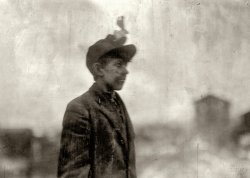
- Ewen Breaker: 1911
- Noon hour in the Ewen Breaker, Pennsylvania Coal Co., South Pittston. January 1911. Spooky full image. Photograph by ... pickers, sat astride the breaker chutes, through which the coal roared, and picked out slate and other debris by hand. Boys as young as 8, ... JOSEPH SHIMKO
(The Gallery, Bizarre, Kids, Lewis Hine, Mining) ... Posted by Dave - 06/09/2018 - 3:23pm -
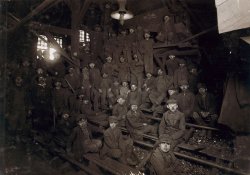
- Breaker Boys: 1911
- ... Pa. "Breaker boys working in Ewen Breaker of Pennsylvania Coal Co." Photograph by Lewis Wickes Hine. View full size.
Faces ! ... on kids working on the breakers. Title "The Kingdom of Coal" authors Donald L Miller and Richard E. Sharpless copyright 1985 by The ... had to take out the garbage.
(The Gallery, Lewis Hine, Mining) ... Posted by Dave - 09/21/2012 - 10:28pm -
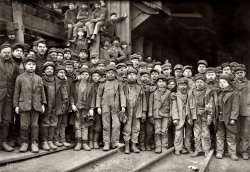
- Expect Delays: 1939
- ... head and maybe try it again on Wednesday.
Canary in a Coal Mine Franklin Co. was a bustling hub of mining when this photo was taken. More than a dozen mines operated then, ... Posted by Dave - 11/28/2017 - 7:54pm -
![Expect Delays: 1939 January 1939. "Highway in Franklin County, Illinois." Medium format negative by Arthur Rothstein for the Farm Security Administration. View full size.
Illinois backroads.I was stationed at Chanute AFB in Champaign County, Iliinois in the early '70's and my friends and I all had street legal dirt bikes that we rode all the county and environs. It was all farm roads and four digit state roads, mostly unpaved, that allowed us to go just about anywhere without traveling on a paved road for miles. Great fun!
Two signsI think I'd turn around, head back the way I came and not take any chances.
L.E. DirdenLoren Edgar Dirden was born in 1890 in Carmi Illinois and died in 1967 in Franklin County Illinois. A draft card from 1941 can be found in a document called "Old Mans Draft Cards, Franklin County Illinois". He was 51 at the time.
"Expect Delays"This is where any road gets interesting!
Terrible TwosdayWell, between this and the foregoing Private Entrance: 1936, it looks like a good day to have pulled the covers over one's head and maybe try it again on Wednesday.
Canary in a Coal MineFranklin Co. was a bustling hub of mining when this photo was taken. More than a dozen mines operated then, including the one seen in the background here, providing rapid count growth in the early part of the 20th century. It also made for a poignant tie to the sign in the photo, "Prepare to meet thy God," as 119 miners lost their lives at the Orient #2 mine on Dec. 21, 1951 due to a methane gas explosion. There was only one survivor.
Going PostalThe front mail box belongs to an H. Butler. In the 1940 census, there was a Hershal Butler living on an "improved road" running west from Hwy 37 and near the Bethel Church, still extant on a route now bisected by I-57. In between the main route and that rural road was the Orient #2 mine mentioned in a prior comment. It's a fairly safe bet that the mine from the 1951 Franlin Co. tragedy is the one depicted in the background here. Fortunately for H. Butler, he was not amongst its victims. He died in 1949.
Mail box questionThe smaller mail boxes with the flapper make sense. One can padlock the box at the top and still receive mail kept from prying eyes. I cannot see what the purpose of the ability of pad locking the type like the large one and getting no mail. Bombs?
[That assembly at the front top of the box isn't for a lock - the lower section serves as a handle for opening the door and also as a latch to secure closure when engaged with the upper part. A lock requiring the carrier to have key in order to deliver mail into a box isn't permitted. -tterrace]
(The Gallery, Arthur Rothstein, Cars, Trucks, Buses, Railroads, Rural America)](https://www.shorpy.com/files/images/SHORPY-8b17426a.thumbnail.jpg)
- Hard Times: 1935
- ... of Morgantown when the old place was obliterated by a coal mine.
The many rugs reminds me of The many rugs reminds me of my ... was taken. The most likely location is the nearby mining community at Scotts Run where Walker Evans spent several months. ... Posted by Dave - 09/05/2012 - 6:06pm -
![Hard Times: 1935 July 1935. "Interior of unemployed man's house. Morgantown, West Virginia." Large-format nitrate negative by Walker Evans for the FSA. View full size. Interesting recent NYT article: "On the Path of Walker Evans."
What is itThe item stuffed behind the mirror? Is is the same thing as what is on the dresser on the right? It looks to me like a kleenex box - but I don't know if they had those back in 1935.
Also I thought the carpet was all one piece, but it looks like multiple carpets "tetris-sized."
[That's a thermometer behind the mirror. - Dave]
TimelessOne of the more interesting studies we've been treated to yet. Wonderful.
Meeting of artist and subjectThis photo is typical of the dignity that Evans captured in the lives and surroundings of ordinary people. I can also say, as the descendant of unemployed Appalachian people of the 30s, that there was dignity there to be captured.
DignityThese people may be poor and struggling, but everything is clean and orderly. They may be short on money but not pride.
No Job, But Not UnappreciatedGreat photo. The man who lives in these modest digs has won the attention of some woman. Either that or he's unusually gifted at laundering and starching doilies!
It Just So Happens.......that CBS's excellent television show "Sunday Morning" had a segment on Walker Evans, his postcard collection, his photography and post card history in general. It was aired this morning.
New slogan for Dave: "Everything's up to date on Shorpy."
Interesting scene, butWhat stands out when I look at this image is the application and condition of the wallpaper.
Farm Security AdministrationThis picture is on the FSA website. Many other pictures by Walker Evans. Very interesting site.
http://xroads.virginia.edu/~UG97/fsa/welcome.html
Modest but niceThey may have been of modest means, but the house looks nice, as evidenced by the trim, and the banister on the staircase (most houses were well-made then), and the furniture appears to be of good quality as well.
No Sneaking Around That HouseThose floor boards creak with every step.
Picture-in-PictureI like the picture above the mirror. Perhaps that is where this unemployed gentleman grew up. Horses and no cars would seem to indicate an earlier date than 1935. Looks like a lovely place.
WowThis pic is what great photography is all about.
Bygone craftsmanshipBetter construction & better furniture indeed. Compare this to the trash-out foreclosures of today, where dumpsters full of imported crap must be hauled off to the landfill before the owners can start replacing floors, windows, cabinets, and basically everything including the kitchen sink. On the other hand, we've already cut down all the nice trees they made this stuff out of.
Pictures of homeIs that the old homestead pictured over the mirror? Maybe our guy had to move to the big metropolis of Morgantown when the old place was obliterated by a coal mine.
The many rugs reminds me ofThe many rugs reminds me of my Granddad's house, where you'd hardly ever see the wood floors. The idea was that every 6 months, all of the rugs would be taken out and beaten. Even into the 1990's when he was in his 90's he did that.
Morgantown EmploymentStanton_Square has been greatly moved by this photograph and has experienced considerable ruminations on how to respond. The typographic servant of Stanton_Square has deep connections to Morgantown, having spent many formative years there. I am very curious as to where this photo was taken. The most likely location is the nearby mining community at Scotts Run where Walker Evans spent several months. Other Morgantown industrial regions of the time include the glass factories along the Monongahela River or the Sabraton neighborhood. Several decades ago I frequented the (still operating) Seneca Glass Factory and a few old houses nearby and felt a similar aura of proud, tidy modesty. The Library of Congress has a handful of Walker Evans panoramas of houses in the region Morgantown but I am at a loss to confidently identify their location.
Ironic to this photo, Morgantown was recently recognized as having the nation's lowest unemployment rate (Dec 2008).
(The Gallery, Rural America, Walker Evans)](https://www.shorpy.com/files/images/8c52045u.thumbnail.jpg)
- American Dream: 1936
- May 1936. "Home of worker in strip coal mine. Cherokee County, Kansas." Photo by Arthur Rothstein for the ... Cherokee County so I am very familiar with the history of coal mining in that county and also the lead and zinc mines in the southeastern ... Posted by Dave - 07/23/2014 - 12:59pm -
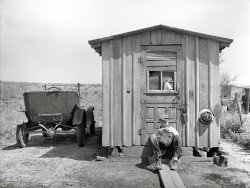
- Watch Your Fingers
- Machine used in mine that digs the coal and loads it on the car. With it three men can do the work of 50 in the ... rendering plant.
(Technology, The Gallery, Lewis Hine, Mining) ... Posted by Dave - 07/27/2012 - 9:54am -
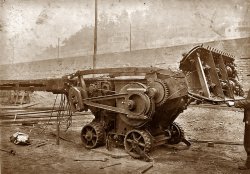
- Meet the Yensers: 1940
- ... of East, Upper, and Lower Mauch Chunk, a small historic coal mining town in the Lehigh Valley." Medium format negative by Jack Delano. ... Posted by Dave - 05/04/2019 - 10:35pm -
![Meet the Yensers: 1940 August 1940. "The family of John Yeuser [i.e., Yenser]. Mauch Chunk, Pennsylvania. Photos of East, Upper, and Lower Mauch Chunk, a small historic coal mining town in the Lehigh Valley." Medium format negative by Jack Delano. View full size.
I had to do it- - I looked up how to pronounce Mauch Chunk.
Big TimeThat's one huge kitchen clock.
Meet the YensersA typographical error on Jack Delano's photo records changed Yenser to Yeuser. From left to right: Raymond (14), John Jr. (16), John Alvin (63), Rebecca (40), Minerva (12), Sarah (18) and Anna (10) per the 1940 census:
https://www.archives.com/GA.aspx?_act=ImageViewCensus1940&FirstName=John...
+20 minutesAnd it's time to reveal the phantom clock.
Back in timeAnd there's that double exposure clock - about 20 minutes later.
Doorkey MemoriesI'll bet my own money that the skeleton key on the nail beside the door is rarely used. I grew up in small town Pennsylvania in the fifties and sixties and remember the door key being on a nail and can't remember it ever being used. As a side note, that pendulum clock appears to be either avant-garde or primitive given the time and place and Mom looks like she has a secret.
American Gothic resemblanceTake a look at John and Rebecca, then look at Grant Wood's famous painting American Gothic.
Sarah R. (Yenser) Gebec obit and family infoSarah R. (Yenser) Gebec, 89, of Hellertown, died Thursday, September 8, 2011 at Phoebe Richland Health Care Center, Richland Twp. She is the wife of the late Edward J. Gebec. Born in Mauch Chunk, Carbon County on December 25, 1921, to the late John A. and Rebecca (Rackawack) Yenser. She worked in the Labor/Construction Department of the Bethlehem Steel for 30 years retiring in 1972. Sarah was a member of Mauch Chunk Jr./Sr. High Alumni Association, Jim Thorpe Area Athletic Association and the Saucon Valley Community Center. Survivors: Sister Minerva C. Sheremetta of Bethlehem; nieces and nephews, great-nieces and nephews, great-great nieces and nephews; Predeceased by her Brothers John T. & Raymond and a Sister Ann Yenser.
Minerva passed away not long after:
Mrs. Minerva C. Sheremetta, 85, formerly of Coatesville, died Thursday, Dec. 5, 2013. She was the widow of Paul S. Sheremetta. She was employed for 19 years as a home and office manager for the late Dr. Mitchell, East Mauch Chunk, and was also a seamstress in Lehighton. Born in Mauch Chunk, she was a daughter of the late John A. and Rebecca M. (Rackawack) Yenser. She attended the former Mauch Chunk Jr.-Sr. High School. Surviving is her niece and caregiver, Janet M. Gebec of Bethlehem.
Maybe it's Yinser (Yinzer)They're not that far from Picksburgh
Not to be confused with the YinzersThey're way over on the west side of the state.
Mauser Mill Co.Here's a pic of the Mauser Mill Company, the name of which appears on their wall calendar. https://picryl.com/media/mauser-mill-company-breadfruit-drive-at-lehigh-...
Once the land of opportunityNE Pennsylvania's mills and mines attracted a lot of immigrants back in the 19th century. Poles, Welsh, Irish, Italians. BTW Mauch Chunk was renamed Jim Thorpe back in the 1950s, but my family (who lived farther north) pronounced it like "Mock Chunk."
Call it "Jim Thorpe" nowIn the 50s, the Thorpe family could not bury him in his native Oklahoma. Mauch Chunk was trying to attract business, so they offered to bury him there and erect a monument. I don't think Thorpe ever set foot there, he went to college in Carlisle, 100 miles away. His widow wanted the money and the town got its name changed.
What's in a name?Real name Yenser? There goes my Yeuser-friendly joke.
Mission style clockIt would have been 20+ years old by 1940, assuming the initial popularity of Mission oak furnishings was roughly during the 1910-1920 decade. Thousands of similar clocks were made and were frequently given as presents to new subscribers of local newspapers. My similar clock bears a hand written inscription indicating it was a 1915 gift from a California daily paper.
(The Gallery, Jack Delano, Kitchens etc., Mining)](https://www.shorpy.com/files/images/SHORPY-8c02893a.thumbnail.jpg)
- Almost Heaven: 1938
- September 1938. "Section of coal mining town near Welch, West Virginia." Possibly the mountain hamlet of Eckman. ... bridge.
The track behind the workmen must lead to the coal hoppers in the other pic:
https://www.shorpy.com/node/24494
... Posted by Dave - 04/08/2019 - 11:47am -
![Almost Heaven: 1938 September 1938. "Section of coal mining town near Welch, West Virginia." Possibly the mountain hamlet of Eckman. Medium format negative by Marion Post Wolcott for the Farm Security Administration. View full size.
BZZTThe Virginian Railway electrified about 130 miles of their railroad in the 1920s using 11,000 volts AC. Presumably the power was off during the operation captured in the photograph.
Why OSHA existsThe guy working on the power lines is putting himself in peril by 1.) possibility of electrocution from the electric lines themselves, and 2.) the possibility of a train coming through and taking out both him and his crew. Meanwhile, up the side of the hill, we see several very nice homes, and, knowing what I know about how plumbing works, and how **it flows, I'd probably rather own one of the homes higher up on the hill, thank you.
[If only we had been there to guide them! The worker's ladder is next to the tracks, not over them. - Dave]
Stairway to Heaven?Are those steps in the left hand of the photo leading up the hill? Covered drainage? If they are stairs they might be more precarious than that ladder the lineman is using! In the words of an old Bugs Bunny cartoon, "Watch that last step, it's a lulu!"
In the days before cherry-pickersYou had to use huge ladders to get up on the poles if you didn't have those pegs that were mounted on some poles.
HemphillLooks like the bridge is the one over the Tug Fork at 37.44116N 81.5931W. The railroad is the Norfolk & Western, and the bridge is 893-B, as the white-lettered marker probably says, just left of the catenary pole left of the bridge.
The track behind the workmen must lead to the coal hoppers in the other pic:
https://www.shorpy.com/node/24494
MoonshineSo, Dave, where is it?
Tall shortI know Shorpy. Is the guy on the ladder his brother Shorty?
In-house wire workThis is certainly a railroad crew working on the catenary. Note the short "train" in the left background. The enclosed car is what powered them here from their starting point, typically with a one-lung gasoline engine and perhaps built by Fairmount; the several four wheeled trailers carry their tools. This sort of RR maintenance crew transport is about nonexistent today, being replaced by high rail-equipped highway vehicles.
These guys are not here on their own; the dispatcher knows of their presence, and likely has given them train orders advising them of the limits they can work, and when they have to be clear of his railroad, or check back with him for further orders.
Tug ForkBased on Timz' ID of the trestle, it is over the Tug Fork, which flows northwest into Hatfield and McCoy territory. Based on the shadows, the shot was likely taken from the north bank looking southwards in the early morning. I guess the Google crew couldn't make it up the road.
RR Safety ProcedureThis being 1938 and not 1838, railroad safety procedures dictated that whoever was in charge of whatever work was being done had undoubtedly coordinated with the dispatcher, who issued "time & track" orders to all concerned, including train crews.
ImpressiveFirst the large white building with the top balcony leaning a bit; and then the male undershorts flying in the wind.
Lionel landscapeThe clean, simple bridge and the foreshortened look produced by the close and nearly vertical background make this scene look like a very well done model train layout!
Space XIf you travel a short distance to the north west along these tracks using the magic of Google Earth, you will find this secret missile launch pad disguised as an old steam locomotive coaling tower.
HemphillThe picture is Hemphill, WV.
(The Gallery, Boats & Bridges, M.P. Wolcott, Mining, Railroads)](https://www.shorpy.com/files/images/SHORPY-8c09394a.thumbnail.jpg)























